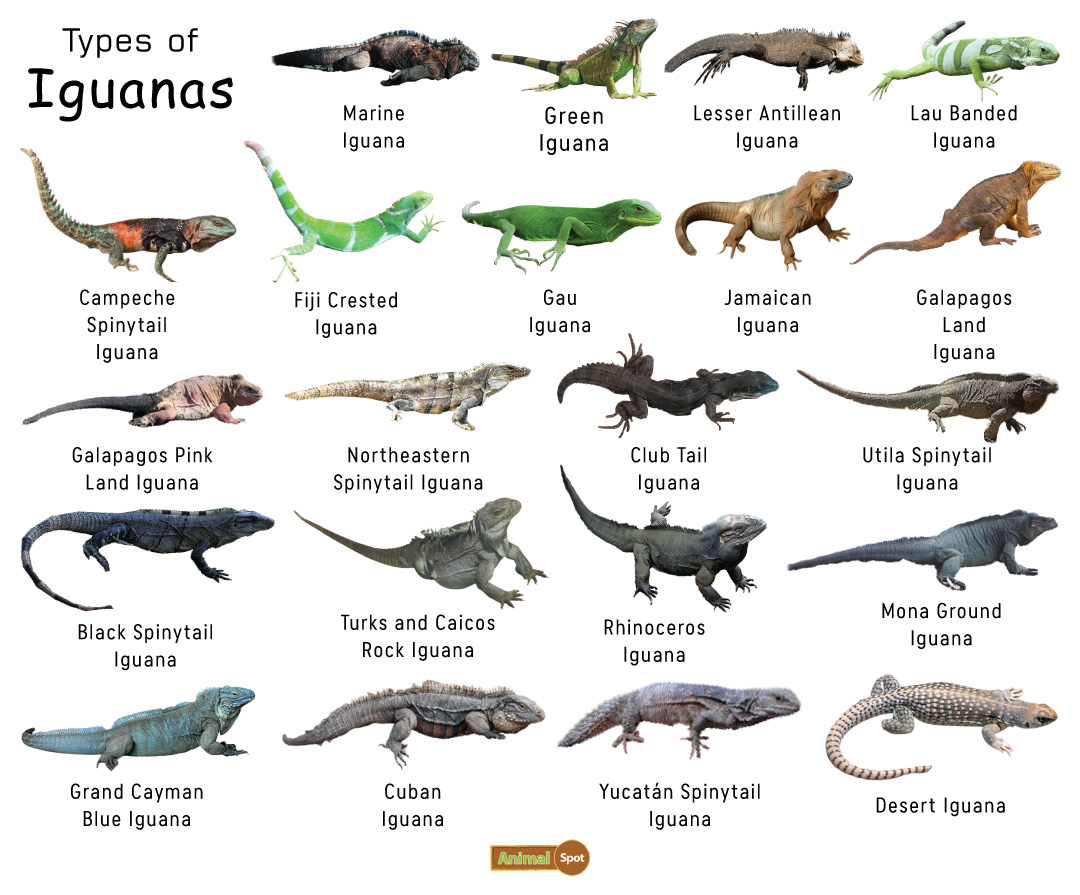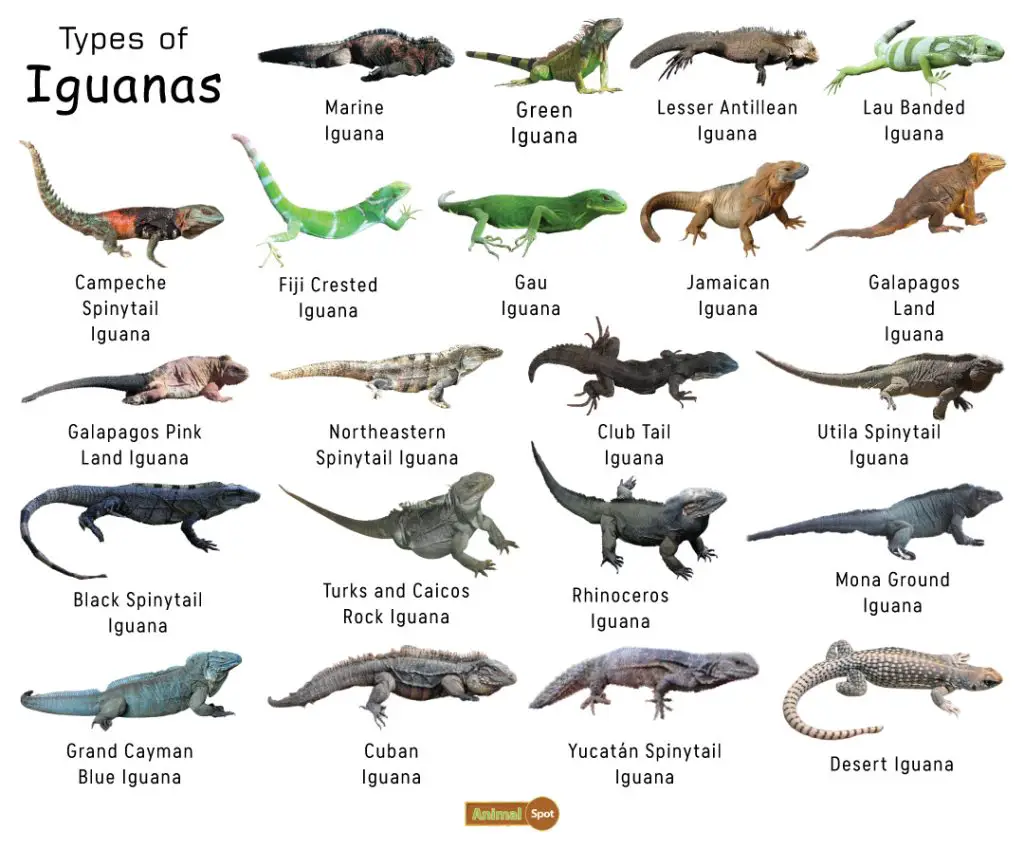Iguanas are fascinating creatures that come in many different shapes and sizes. From the tiny spiny-tailed iguana to the majestic green iguana, these reptiles are a favorite among pet owners and wildlife enthusiasts alike.
In this article, we’ll explore the various types of iguanas, their unique characteristics, and what makes them so special. Whether you’re a seasoned reptile owner or just starting to learn about these fascinating creatures, you’re sure to find something interesting in our guide to the different types of iguanas. So, let’s get started!
There are several types of iguanas, including the green iguana, blue iguana, rhinoceros iguana, and red iguana. Green iguanas are the most common and can grow up to 6 feet long. Blue iguanas are native to the Grand Cayman Island and are critically endangered. Rhinoceros iguanas are named for their bumpy skin, and can be found in the Caribbean. Red iguanas have a reddish-brown color and are found in Central and South America.

Types of Iguanas – A Comprehensive Guide
Iguanas are one of the most fascinating reptiles on the planet. They are known for their unique appearance, behavior, and adaptability. Iguanas are native to Central and South America, but they can be found all over the world as pets. There are several types of iguanas, each with its own distinct characteristics. In this article, we’ll explore the different types of iguanas and their unique features.
1. Green Iguana
The green iguana is the most common type of iguana and is also known as the common iguana. They are native to Central and South America and are known for their bright green color. Green iguanas are herbivores and primarily feed on leaves, fruits, and flowers. They are also known for their large size, reaching up to 6 feet in length.
Green iguanas make great pets, but they require special care. They need a large enclosure with plenty of room to climb and bask. They also require a specific diet and temperature range to thrive. Green iguanas can be a bit challenging to care for, but they are also very rewarding pets.
2. Blue Iguana
The blue iguana is a critically endangered species native to the Grand Cayman Island. They are known for their blue color, which is most vivid in males during mating season. Blue iguanas are herbivores and primarily feed on fruits and flowers.
Due to habitat destruction and poaching, blue iguanas are one of the rarest iguana species in the world. Fortunately, there are conservation efforts in place to protect and breed these beautiful reptiles.
3. Rhino Iguana
The rhino iguana is named for the horn-like protrusions on their snouts. They are native to the Caribbean and are known for their docile temperament. Rhino iguanas are herbivores and primarily feed on leaves and flowers.
Rhino iguanas make great pets, but they require a bit more care than some other types of iguanas. They need a specific diet and temperature range to thrive, and they can be a bit more aggressive than other types of iguanas.
4. Red Iguana
The red iguana, also known as the Mexican spiny-tailed iguana, is native to Mexico and Central America. They are known for their red color and spiny tails. Red iguanas are omnivores and eat a variety of fruits, vegetables, and insects.
Red iguanas make great pets, but they require a specific diet and temperature range to thrive. They are also known for their aggressive behavior, so they may not be the best choice for novice reptile owners.
5. Black Iguana
The black iguana, also known as the black spiny-tailed iguana, is native to Central and South America. They are known for their black color and spiny tails. Black iguanas are herbivores and primarily feed on leaves and flowers.
Black iguanas make great pets, but they require a specific diet and temperature range to thrive. They are also known for their aggressive behavior, so they may not be the best choice for novice reptile owners.
6. Desert Iguana
The desert iguana is native to the southwestern United States and Mexico. They are known for their beige color and ability to survive in harsh desert environments. Desert iguanas are herbivores and primarily feed on leaves and flowers.
Desert iguanas make great pets, but they require specific care and a specific diet to thrive. They are also known for their skittish behavior and may not be the best choice for novice reptile owners.
7. Chuckwalla Iguana
The chuckwalla iguana is native to the southwestern United States and Mexico. They are known for their plump, round bodies and ability to inflate themselves to deter predators. Chuckwalla iguanas are herbivores and primarily feed on leaves and flowers.
Chuckwalla iguanas make great pets, but they require specific care and a specific diet to thrive. They are also known for their skittish behavior and may not be the best choice for novice reptile owners.
8. Fiji Banded Iguana
The Fiji banded iguana is native to Fiji and is known for its distinctive stripes and bright colors. They are omnivores and eat a variety of fruits, vegetables, and insects.
Fiji banded iguanas make great pets, but they require specific care and a specific diet to thrive. They are also known for their skittish behavior and may not be the best choice for novice reptile owners.
9. Cuban Rock Iguana
The Cuban rock iguana is native to Cuba and is known for its large size and spiny tail. They are herbivores and primarily feed on leaves and flowers.
Cuban rock iguanas make great pets, but they require specific care and a specific diet to thrive. They are also known for their aggressive behavior and may not be the best choice for novice reptile owners.
10. Galapagos Land Iguana
The Galapagos land iguana is native to the Galapagos Islands and is known for its distinct yellow color. They are herbivores and primarily feed on leaves and flowers.
Galapagos land iguanas make great pets, but they require specific care and a specific diet to thrive. They are also known for their skittish behavior and may not be the best choice for novice reptile owners.
In conclusion, there are several types of iguanas, each with its own unique features and care requirements. If you’re considering getting an iguana as a pet, it’s important to research the specific type of iguana you’re interested in and make sure you’re prepared to provide the care they need. With proper care, iguanas can make wonderful pets and fascinating additions to any reptile collection.
Frequently Asked Questions
What are the different species of iguanas?
There are various species of iguanas, such as the Green Iguana, Blue Iguana, Desert Iguana, Spiny-tailed Iguana, and many more. Each species has its distinct characteristics and habitat requirements. The Green Iguana is the most common pet iguana and is known for its bright green color and docile nature.
However, it’s essential to note that owning an iguana, regardless of the species, requires a lot of care and attention. You must research and understand the specific requirements of each species before getting one as a pet.
What is the lifespan of iguanas?
The lifespan of iguanas varies depending on the species and their living conditions. Typically, iguanas can live for 10-20 years in captivity and up to 25 years in the wild. However, some species such as the Galapagos Land Iguana can live for over 50 years.
To ensure your iguana lives a long and healthy life, it’s crucial to provide them with a suitable habitat, a balanced diet, and regular veterinary check-ups.
What do iguanas eat?
Iguanas are herbivores, which means they eat only plants. Their diet should consist of a variety of fruits, vegetables, and leafy greens. The specific diet will depend on the species of iguana you have, but some common foods include collard greens, kale, dandelion greens, and butternut squash.
It’s important to note that iguanas require a well-balanced diet to maintain their health. You should avoid feeding them processed foods, high-protein diets, and anything that contains animal products.
How do I create a suitable habitat for my iguana?
Creating a suitable habitat for your iguana involves providing them with enough space, food, and light. The enclosure should be large enough for your iguana to move around freely, and it should also have adequate heating and lighting.
You can use materials such as reptile carpet or newspaper as a substrate, and provide hiding places and climbing structures. It’s also essential to maintain proper humidity levels and keep the enclosure clean to prevent the growth of bacteria that can harm your iguana.
Can iguanas be kept as pets?
Yes, iguanas can be kept as pets, but it’s crucial to understand the specific requirements of each species before getting one. They require a lot of care and attention, and their size and dietary needs can make them challenging to care for.
It’s also important to note that iguanas can become aggressive and territorial, especially during breeding season. Therefore, it’s essential to handle them carefully and avoid any aggressive behavior. If you’re considering getting an iguana as a pet, do your research and consult a veterinarian or an experienced reptile keeper for guidance.
In conclusion, learning about the different types of iguanas can be a fascinating experience for reptile enthusiasts. These incredible creatures come in a variety of shapes, sizes, and colors, each with their own unique characteristics and traits. Whether you’re interested in the gentle nature of the green iguana, the striking beauty of the blue iguana, or the unusual appearance of the spiny-tailed iguana, there’s sure to be a type of iguana that captures your attention.
If you’re considering getting an iguana as a pet, it’s important to do your research and choose the right type for your lifestyle and living situation. Some iguanas require more care and attention than others, so it’s crucial to make an informed decision before bringing one home. Additionally, iguanas can live for up to 20 years or more, so be prepared for a long-term commitment.
Overall, whether you’re a seasoned reptile enthusiast or just starting to explore the world of iguanas, there’s always more to learn about these fascinating creatures. So why not dive in and discover all the amazing types of iguanas out there? Who knows, you might just find your new favorite reptile!


